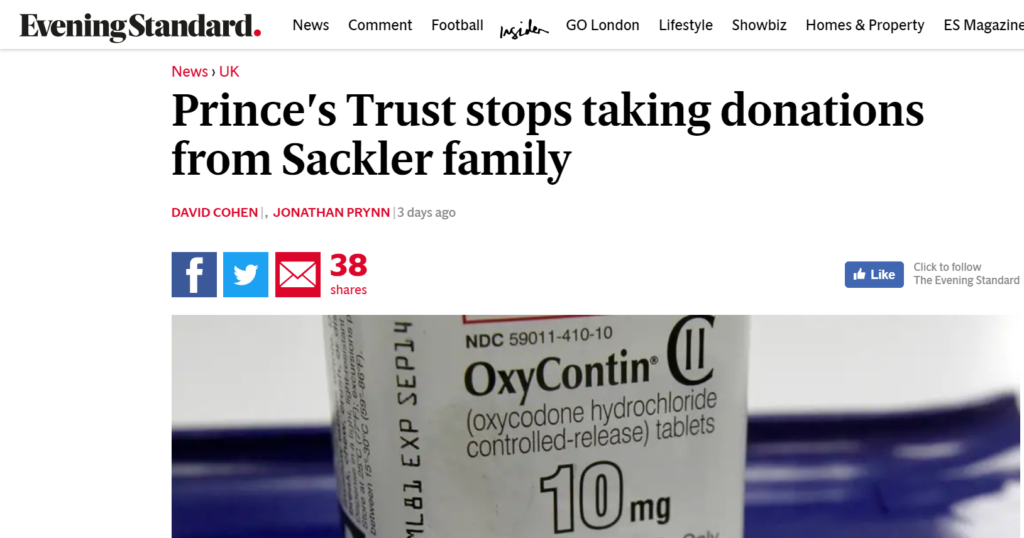
Ethics post #4
Money, scandal and the Royal Family … we all love a headline with some spectacle, don’t we? No hint of sex but plenty of blood and potential for voyeurism as we watch the Sackler name hemorrhage its wealth-bought nobility. Plenty of outrage and righteousness as well, as we feed on charges that Sackler fortunes were considerably enriched by unleashing an opioid addiction epidemic.
Spectacle, though, seems almost definitionally concerned with the tip of the iceberg. As museums say no to the Sacklers, humanitarians should pay attention, particularly to what lies beneath the surface.
The Sacklers were no small donors, charitably contributing piles of wampum to acquisitions and exhibitions across the major museums of the West. Their philanthropy helped establish a great deal of beauty in the world. One common view is that the ends justify the means – ignore where the money came from as long as it is not illegal or scandalous (and hence reduce future donations). After all, museums are purposed to house artistic endeavor, not advance one or another of thousands of social causes. In this view, the refusal of Sackler funding does not mean morally cleaner art; it means less art and less public accessibility to art.
And then there is the other view. Renowned photographer Nan Goldin fingered the Sackler family due to her own addiction to opioids, threatening to pull her work out of museums and staging protests. The story flared across the media. Donations from the Sacklers thus moved from philanthropic monuments to scandalous gestures (reputational risks). Even so, for many museums the money proves too substantial to walk the path of refusal.
Humanitarian agencies are similarly thought of as public goods and moral actors. They often act pragmatically or in institutional self-interest and they often act on the general moral principle of not taking dirty money. Further, humanitarian power to act depends heavily upon moral legitimacy, and this prompts a more specific moral principle that often guides agency donor policy: whether or not there is a direct connection of the wealth being donated to the suffering of people affected by crisis. It is easy to understand why a health NGO might have more concern with accepting a grant from the pre-spectacle Sacklers than would, say, an environmental agency.
Here is a first chunk of submerged iceberg. As I’ve blogged recently, our heightened awareness of the causes of crisis requires a new equation in humanitarian donor policy. “Given its increasingly clear role in the conflict and suffering to which we respond … is an enormous chunk of our support produced in the factories of inequality?” Otherwise said, what of the responsibility to interrogate the consequences on inequality of the business behind hedge fund philanthropy? And if not inequality, perhaps the destruction of the environment or contribution to climate change? Or maybe the uber-profitable generation of democracy-killing echo chambers and election fraud?
This is where the spectacle above comes in. Because what we have in that headline is not a museum, but the British Royal Family (the Prince’s Trust) cutting ties with the Sacklers. Now, I don’t want to pick on the Monarchy just to make a point (or maybe I do), but their wealth has a particular history, one fused with England’s colonial legacy of violence and destruction. The latter would seem to dwarf even the horrors of opioid addiction. So what does it tell us when the human embodiment of Empire decides that Sackler money is too dirty?
It tells us that the vilification of the Sacklers does not threaten but actually safeguards the commonplace acceptance of funding from tainted sources. It installs a process whereby demonization of the most pathological masks the pathology of the norm. At best, this marks the triumph of what Hannah Arendt might label ‘lesser evils.’ It seems more likely, however, that the spectacle of this headline marks a textbook example of how power works to preserve the status quo. The Sacklers now define and embody the rule; they become not just the devil we know, but the way we picture the devil, the standard of what we relegate to devildom. It may mean a little less art, but it does not herald a new ethical scrutiny of the way questionable money pays for seemingly unquestionable good works.
Stay tuned. Time to question the unquestionable? The second chunk of the submerged iceberg may be even more concerning.